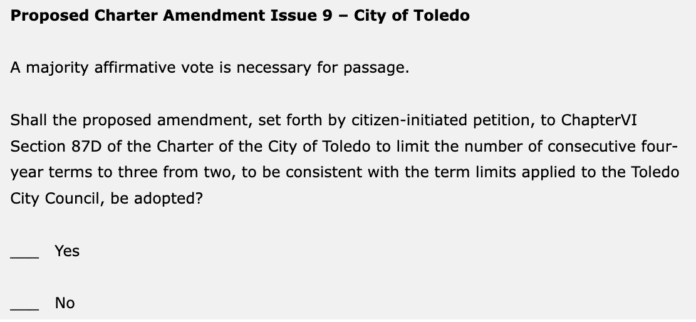Editorial cartoon by Don Lee for the Toledo Free Press.
Army medic returns home
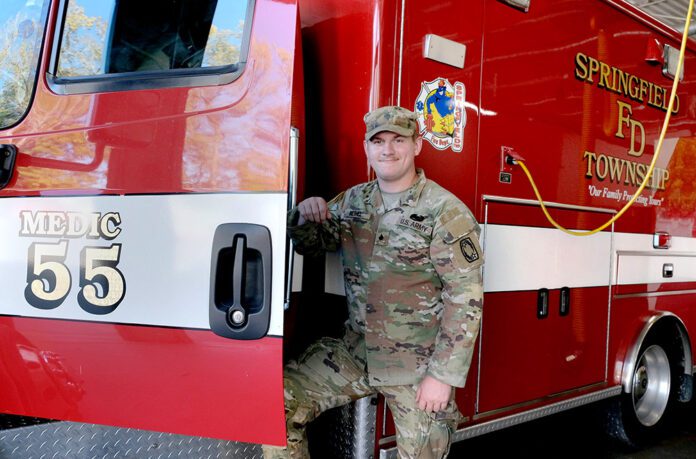

Springfield Township Fire & Rescue taps into army internship program
HOLLAND – Members of the U.S. army can often find it challenging to make the transition from military to civilian life, particularly when it comes to employment. To help ease that burden, the army created an individual internship program that partners soldiers with civilian companies.
Since 2013, the army’s Career Skills Program (CSP) has helped 49,965 soldiers complete one of the 226 CSPs, and has partnered with more than 4,000 employers to deliver a 93 percent hire rate.
Springfield Township Fire & Rescue has tapped into that program, which they hope will gain the department a well-qualified firefighter and medic.
That soldier is combat medic and emergency medical technician (EMT) Army Spec. Brian Bethel, 26, who joined the army in 2021 and is scheduled to be honorably discharged in January. Currently an active duty combat medic, Bethel has been interning with his local fire department since the first week in July.
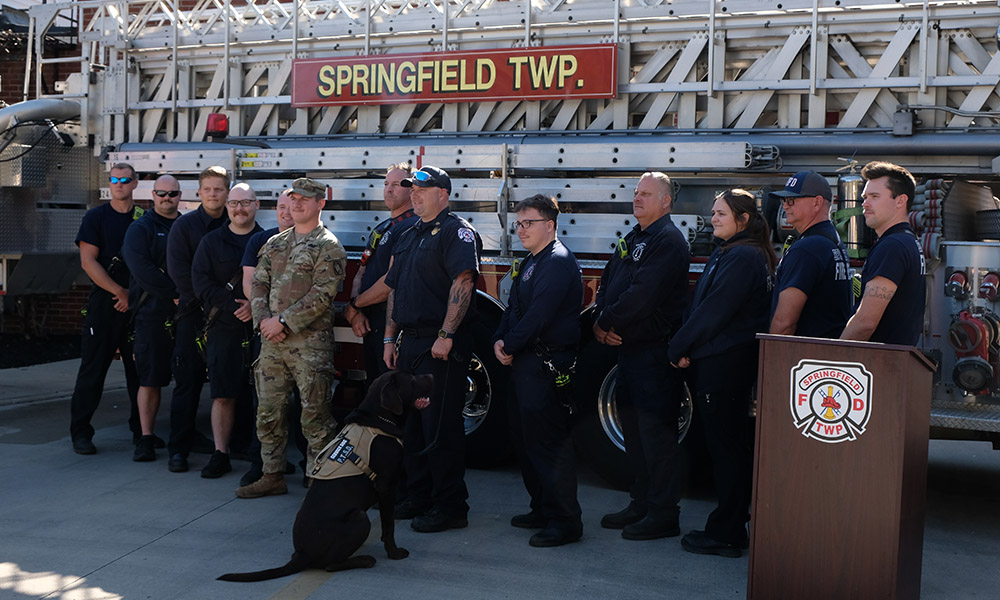
When his internship expires this month, he’ll return to his active duty station with the 144 Air Defense Artillery (ADA), 69th Brigade, at Fort Cavazos (formerly Ft. Hood) in Texas until his ETS (expiration term of service) date of Jan. 3.
“For now, this is my place of duty, and the army can check in with them (his supervisers) whenever they want to make sure I’m doing okay,” Bethel said. “It’s been so helpful to transition. I can’t thank enough to the department and to the army for allowing this to happen.”
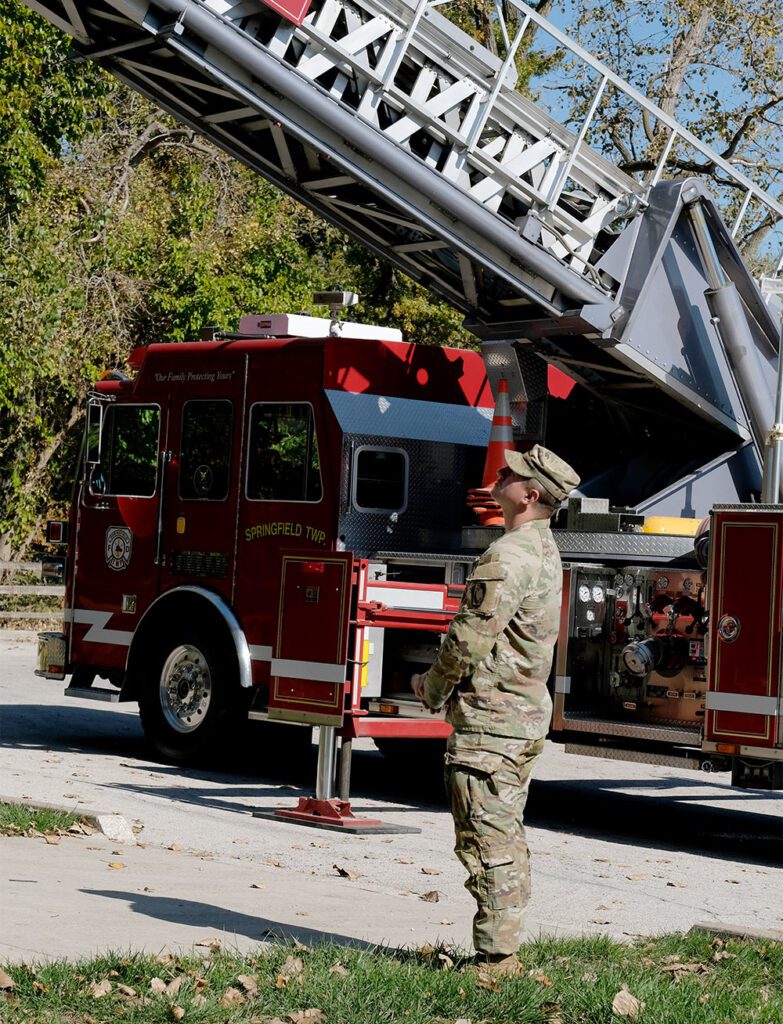

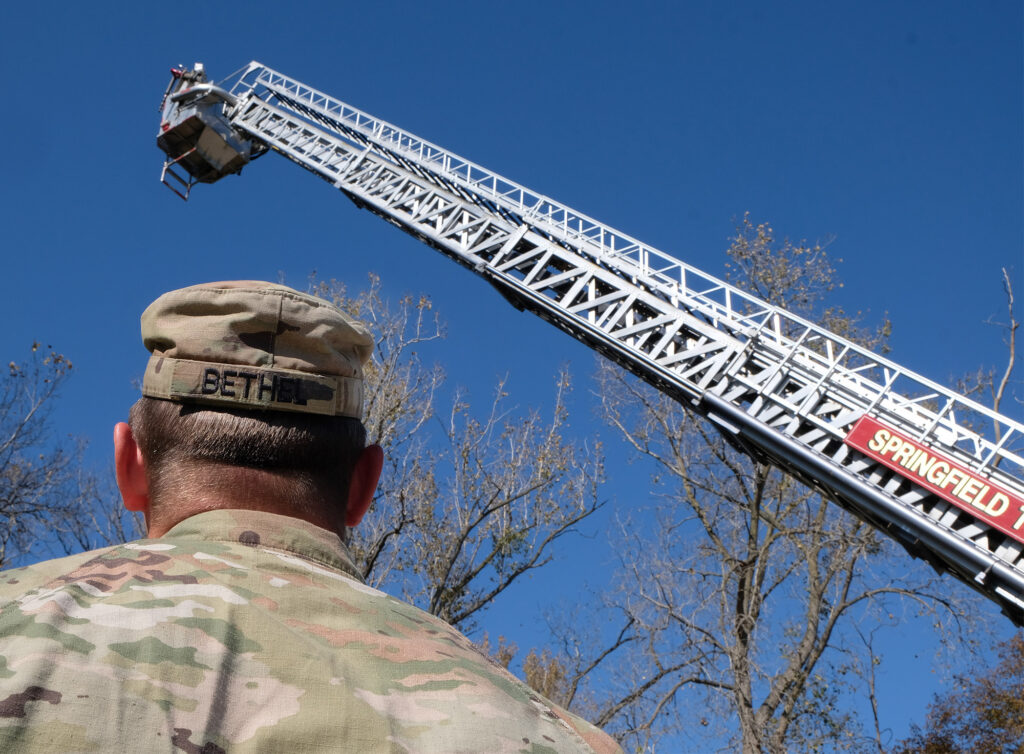

Over the past few months, Bethel said he’s learned about the department’s work schedules, how a fire department runs and “just how good Springfield Township fire department actually is.”
He said his goal is to learn what being a firefighter and EMT/paramedic entails. He’s already experienced in dealing with trauma as a combat media, and that has helped him with his civilian firefighter training.
Bethel said the program has been very helpful because he had no idea what being in the fire service or being a civilian was like. “This was a great way for me to transition from being an active duty soldier back to a civilian, where I don’t have to show up to PT (physical training) or chow,” he quipped.
Bethel said that everyday he’s proving his worth so he can hopefully come back and work for Springfield Township, where he grew up. He graduated from Springfield High School in 2017.
In addition to on-the-job training, he is also studying to become a paramedic at Owens Community College and taking the Firefighter 1 course at Penta Career Center. The Penta course is part of its short-term firefighter certification programs. Once he is certified, he can apply to work as a civilian firefighter.
Springfield Fire Chief Jonathon Ziehr described the CSP as a “phenomenal program that we should have been doing long ago,” adding that with a shortage of firefighter/EMTs, it’s a way to attract military veterans to the department.
Ziehr admitted the program does have its challenges. Similar to a college transfer, soldiers in the CSP find that the education they receive as a medic, for instance, does not necessarily transfer to EMT or fire certification. The chief said the military, along with federal, state and local government officials, need to work collectively to resolve the issue.
Administrator Mike Hampton hopes to continue the CSP at Springfield. “We see the career skills program as a catalyst to encourage many honorable discharged soldiers to gain additional education and workplace experience during their transition to civilian life.”
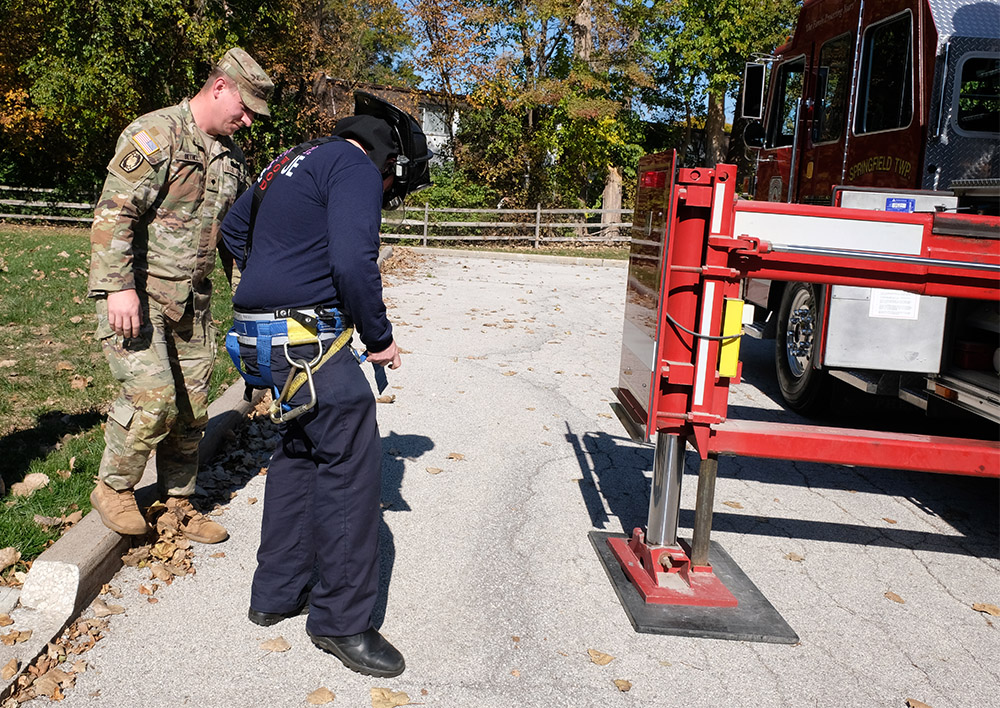

Bethel, who plans to join the national guard in November, comes from a line of siblings who served in the military, and he credits his brothers with helping him choose the army.
“My oldest brother was a marine, my second oldest has been a police officer for the last 16 years, and the third oldest was in the air force for six years and going on seven years in the guard, so having that around me pushed me in that direction,” he said. “But really, I just wanted to serve my country and Springfield Township, which has been the plan all along.”
He also credits his parents for how he was raised. “I just strive to be the best person possible, and I really found helping people, the community and my country is what I love to do.
As for his entering civilian life in a few months, he said he’s prepared. “I want to come back to serve my community. I love it and it makes me happy. That’s all I’m about – coming back to my community to serve and help them. That’s all I can ask for, to help one person a day.”
BGSU No. 1 for veterans
University best for veterans, military students in the midwest
BOWLING GREEN – For the fourth consecutive year, Bowling Green State University has been named the No. 1 university in the midwest for veterans and active military students, according to Military Times.
In its 2024 Best for Vets rankings, Military Times also placed BGSU No. 16 among public colleges and universities and No. 20 overall in the nation. BGSU has been consistently ranked by the publication as a top academic choice for veterans and active military students since 2013.
At BGSU, veteran and military students are empowered with comprehensive, personalized support in and out of the classroom. Through the BGSU Office of Nontraditional and Military Student Services, military-affiliated students can embrace dedicated tutoring services, join veteran and military-focused student organizations and discover resources for navigating their education during activations or other circumstances unique to military life.
Military Times’ Best for Vets rankings are based on an annual survey of colleges and universities nationwide to evaluate their veteran-focused programs and resources. Department of Education and Department of Veterans Affairs data are also analyzed for the rankings.
For this year’s rankings, Military Times prioritized student success as the most important factor in determining relative placements, underscoring the University’s commitment to student outcomes. The publication also considered the breadth of military-specific resources and financial assistance available to students among other factors.
BGSU also ranks No. 1 in Ohio as home to the best online bachelor’s degree programs for veterans, according to U.S. News and World Report.
Senior housing groundbreaking


Collingwood Green V apartments becoming a reality
TOLEDO – A groundbreaking ceremony for 75-unit senior apartment complex called Collingwood Green V took place on last month at the corner of Nebraska Ave. and Division St.


This effort comes after years of logistics, funding requests and collaboration involving a collection of nonprofits, businesses and agencies from local to federal. The City of Toledo, Lucas County, Lucas Metropolitan Housing, National Church Residences and Rudolph Libbe Group are the lead partners.
More than 50 people, including LMH staff, elected officials, other dignitaries and news media, attended the presentations and groundbreaking celebrating the housing project, which is aimed at seniors 62 and older who can thrive in independent living circumstances. It’s slated to open in 2026.
“This project is an example of what we can do when we work together,” said Rosalyn Clemens, Toledo Housing and Community development director.
“We’re going to renew possibility in this area so close to downtown,” added U.S. Rep. Marcy Kaptur, D-Ohio District 9, who was among the officials at the presentation.




Funding for the $29 million development includes a total $6.7 million in federal American Rescue Plan Act funds, which were directed from City of Toledo and Lucas County Board of Commissioners authority. Union workers will be involved with the construction.
The Collingwood Green housing development replaces the long-demolished Brand Whitlock and Albertus Brown Homes sites. The Whitlock housing development was one of Toledo’s oldest public housing projects; some of those attending were familiar with the neighborhood and recalled the drab atmosphere.
“They had fallen into a state of disrepair,” described Toledo Mayor Wade Kapszukiewicz.
The Collingwood Green V project will feature 75 one-bedroom units, along with shared space. It adds to a redeveloped neighborhood that is already showcasing colorful exteriors and green space.
“LMH isn’t just building apartments. They are building a community,” said Lucas County commissioner Lisa A. Sobecki.
The reason to focus on seniors is the demographic and population trends in City of Toledo. The 2020 Census showed 14 percent of Toledo residents are 60 and older. The age 85 and older population is specifically increasing at a fast pace, according to the Area Office on Aging of Northwestern Ohio.
“We are living longer as Toledoans, and that’s a good thing,” Kapszukiewicz said.
That trend, however, has an impact on long-range community needs and services.
“Housing is the biggest expense for retirees,” said Bill Harris, immediate past board chair of the Area Office on Aging of Northwestern Ohio.
The speakers emphasized the goal of Collingwood Green V is to provide affordable housing.


The phrase “affordable housing,” Clemens explained, goes beyond the traditional idea of public housing or Section 8 qualifications. Instead, it indicates that housing costs no more than 30 percent of someone’s income. Within that range, individuals and families are better able to afford other everyday expenses, such as car repairs.
“We are showing everyone that decent, safe and sanitary housing is vital for seniors,” said Brian Murray, U.S. Department of Housing and Urban Development Cleveland Field Office director.
Those eligible to live in the upcoming apartment units will be income at or below 80 percent of the Toledo Area Median Income, which is currently $48,650.
More specifically, 30 apartments are intended for seniors at or below 50 percent of the Toledo Area Median Income, which is currently $30,400.
Holiday tips for divorced parents
Minimizing stress on children during the holidays
The statistics for children with separated parents are astounding: In the United States, 50 percent of children will witness a separation of their parents. In addition, 25 million children are growing up in single parent homes. That’s 40 percent of the kids in the U.S., as reported by the Center for Children and Families.
The holiday season is quickly approaching, and for me personally, there is an added stress. Although it is often good stress, the planning, preparing, shopping and cleaning is still taxing. For some households, added to that chaos are the complications of co-parenting and children spending time in multiple homes for the holidays. Many parents will ask me how to handle all of this so they (the children) have a good holiday season.
The difficulties children experience in single parent homes are many, but they can be minimized if both parents work together. In the real world, families, no matter how defined, have conflicts. Stress and disagreements are common, and it is destructive to the family when those conflicts get out of hand. Children are often caught in the middle with devastating effects.


Children caught in the middle of parental conflict experience increased anxiety and depression; they often feel like it is their fault. If they would have been better kids, their parents would still be together, or would not fight. When parents argue, especially about money, children often feel like they are a burden.
So, that leads us to how parents can co-parent well and minimize the effects on their children. Here are some suggestions:
- Be consistent. Both parents need to be specific with each other about what their rules and expectations are for the children. Then they need to come to a compromise and parent with the same rules and discipline. Make sure it is reasonable and something both parents can live with.
- Communication is the most important parenting skill, regardless of whether parents are married. Parents need to commit to talking about every issue regarding their children. Children should not be a part of the conversation; it should be done in private. It may also be helpful to set up a routine where there is weekly communication to keep each other informed and prevent conflict. Another important key is not to talk poorly about the other parent in front of the child. This puts the child in a position of choosing between parents.
- Work on conflict resolution. When parents argue rather than resolving the problem amicably, a power struggle often begins. This leaves one parent often giving in, causing a buildup of anger and resentment. The cycle usually repeats itself with frustration and anger from the previous conflicts resurfacing, adding to the present conflict. This then leaves a buildup of animosity that the children feel.
This is not a healthy. Along with communication, as mentioned above, parents need to learn conflict resolution. According to the American Management Association, the 5 steps to conflict resolution are:
- Define the source of the conflict (listen to each other)
- Look beyond the incident (don’t blame each other; identify the facts)
- Request solutions (give suggestions, don’t just complain)
- Identify solutions both can support (compromise)
- Agree (making sure you have taken into account the other person’s feelings)
The way parents handle the conflict is how your child learns to manage disagreements. Children will watch your behavior more than what you say. The old saying holds true: actions speak louder than words.
A relationship involves two people; it is not one sided. If parents are having conflicts and difficulties, it will disrupt the entire family, and then the children will suffer. The younger the children, the more time you have to build a foundation that enables them to have healthy relationships within and outside of the family.
Don’t waste precious time. Enjoy the holidays and make memories your children will be able to keep with them for a lifetime.
Op-Ed: On Issue 9
Amendment adds third term for Toledo mayors
By Mark Sobczak


Hello, Toledo Free Press readers! Indulge me for a few lines to tell you a little about myself. I am a lifelong Toledoan. I grew up in a working-class neighborhood. Dad was a Toledo police officer and mom, after raising my three siblings and me, worked as a bank teller.
I am not a professional journalist, which will become painfully evident to the Free Press’ more discerning readers. I spent a 35-year career advocating for workers as an officer and business representative for Teamsters Local 20. I was elected as an at-large member to Toledo City Council and served from 2006 to mid-2009, and the last 18 months as city council president.
After retiring from the Teamsters, former Mayor Mike Collins asked me to serve in his administration as the commissioner of human resources for the City of Toledo. One year later, after his tragic and sudden death, then city council president Paula Hicks-Hudson became mayor by succession. Paula contacted me and asked if I would be willing to serve as her chief of staff and director of public safety.
I served for the next three years until current Mayor Wade Kapszukiewicz was elected. During my time as a city councilman, I became friends with Tom Pounds, editor/publisher of the Toledo Free Press. One very early Sunday morning while golfing together, he asked me a question about a City of Toledo water issue. Several holes later, when I felt I had sufficiently answered his question, he said, ‘Wow, you could write a book,” which was code for him seeking a much more succinct response. I realized my TMI moment and we shared a laugh.
But that got us thinking: I might be able to share some of my experiences as a city councilman and administrator with the Free Press readers. So, against that backdrop, I will endeavor to periodically regale the Free Press faithful with insights I have picked up along the way.
Signing the petition
When confronted by an obvious non-Toledoan while attending the Toledo Jeep Fest to sign the petition to put this proposed amendment on the ballot, I initially hesitated. Normally, I will sign just about any petition or accept any flyer/handout, sympathetic to the rejection invariably faced when interrupting someone’s day by asking them to sign or read something.
At first, I thought ‘No, I won’t sign.’ Then I thought, ‘Well, this is not a vote for Wade’s third term. He would still have to run again and win.’ Then I got to thinking about who are the future Mayor wannabes and whether they may be better or worse than what we currently have.
Proposed Charter Amendment Issue 9 – City of Toledo
A majority affirmative vote is necessary for passage.
Shall the proposed amendment, set forth by citizen-initiated petition, to ChapterVI Section 87D of the Charter of the City of Toledo to limit the number of consecutive four-year terms to three from two, to be consistent with the term limits applied to the Toledo City Council, be adopted?
___ Yes
___ No
The turnover on city council has been rapid as of late, with a few exceptions. Some of the new council members show potential as the city’s leader. Others not so much. But given four more years to demonstrate their acumen for city government, they may just fit the bill. I have often said there are two types of people who run for office: civil servants and self-servants. You can usually spot who is whom from a mile away. We currently have both.
Metaphorically speaking, it takes a new mayor about six months to find their parking space in the government center garage, meaning that time is usually lost to the inevitable transitioning that takes place with a new administration. At the time, I considered the options. Should the amendment pass, Wade will have an opportunity to make his case for what a third term would bring. Should the amendment fail, we lose an option that may have been best. That’s when I grabbed the clipboard and signed the petition.
Now that the results are in, we know that Issue 9 passed: 50,467 YES (55.37 percent) to 40,677 NO (44.63 percent) with 100 percent of precincts counted, which is unofficial until certified.
Wade has stated he will take advantage of the passage of Issue 9 and seek another term as mayor of the City of Toledo, but there hasn’t been an official announcement yet.
So, where are do we go from here? Can the mayor make a cogent case for a third term? Will a current city council member rise to the occasion? Will a local businessperson be willing to take the salary pay cut and jump into the fray? Will a dark horse emerge from the citizenry?
In a post-ARPA (American Rescue Plan Act) funds world, will it be status quo, utopia or an apocalypse? Time will tell. Whomever it is, their success will be the city’s success. As Gene Krantz, our American aerospace engineer heroically said, “Failure is not an option.”
The failure of Ohio Issue 1
Measure failure leaves map making in hands of GOP elected officials
This story was originally published by Signal Statewide Tuesday night. Sign up for their free newsletters at SignalOhio.org/StateSignals.
By Andrew Tobias, Signal Statewide
Ohio voters have defeated Issue 1, giving a huge victory to state republicans who managed to turn the public against the proposed redistricting amendment despite being massively outspent.
The measure’s failure comes after a barrage of pro-Issue 1 ads. The “yes” campaign, underwritten by a handful of national groups and labor unions, outspent Issue 1’s opponents by a roughly seven-to-one margin, according to state campaign finance records.
However, republicans painted the measure as a democratic power grab, releasing ads featuring former president Donald Trump. Republicans also wrote ballot language summarizing Issue 1 that described it as repealing popular anti-gerrymandering reforms passed by voters in 2015 and 2018. Campaigns for and against the measure and their allies agreed the language portrayed the issue negatively and made it less likely to pass.
“Ohio voters spoke loudly and clearly on Issue 1,” Bob Paduchik, a former Ohio republican party chairman who led the anti-Issue 1 campaign, said in a statement.
“Ohio’s constitution is not for sale to foreign billionaires and out of state left-wing special interest groups. Despite democrats’ best efforts to deceive Ohioans into changing our constitution and rigging elections in their favor, the truth has carried the day,” said Paduchik. “We are grateful to our elected republican leaders, the Ohio Republican Party, the Ohio Chamber of Commerce, Ohio Manufacturers Association, and many others that took a stand to protect representational democracy.”
Citizens Not Politicians, the main pro-Issue 1 campaign group, did not immediately issue a concession statement.
Ohio House minority leader Allison Russo, a democrat from suburban Columbus, told reporters after the race was called that the ballot language was “100 percent” why it failed.
“I think if voters had accurate information going into the ballot box, it would have passed overwhelmingly,” she said. “There’s no doubt in my mind that it fell simply because of the misleading ballot language and the abuse of power that happened from people like Frank LaRose.”
LaRose, the republican Ohio secretary of state, chairs the Ohio Ballot Board, the GOP-controlled panel that wrote the Issue 1 ballot language.
When CNP issued a statement around midnight the night of the election, it argued voters against the amendment proposal thought they were voting to end gerrymandering.
“Though we didn’t get the outcome we worked for, we have laid a powerful foundation,” former Ohio Supreme Court Justice Maureen O’Connor, who led the campaign, said in the statement. “We will continue to push for an Ohio where every vote truly counts and where transparency and fairness guide our electoral process. In analyzing the vote tonight, it is clear that the millions of Ohioans who voted yes want to end gerrymandering. And it is also clear that those who voted no thought that they were voting to end gerrymandering.”


The defeat of Issue 1 means that republicans will continue to control redistricting in Ohio. The development has potential national ramifications, since there only a few dozen congressional districts nationally competitive. The dynamic leads the parties to duke it out every two years over control of the U.S. House of Representatives, including this year, when national republicans have tried to retain their narrow control of the chamber.
The development means Ohio will keep redistricting amendments voters approved by overwhelming majorities in 2015 and 2018, with support from both parties. Those reforms were meant to prevent gerrymandering by imposing tougher rules for splitting counties and other communities and including language meant to encourage partisan fairness, although republicans, after winning key statewide elections in 2018, ultimately ended up arguing in court that those requirements were optional.
The rules still did produce more competitive congressional elections in 2020 and 2022, although part of that is a reflection of the profound uncompetitiveness of the republican-drawn maps that the state used for the previous decade.
With Issue 1’s defeat, the Ohio Redistricting Commission, a panel of elected officials that republicans control thanks to their success in the 2018 elections, will remain in charge of redistricting. The panel will redraw Ohio’s congressional maps ahead of the 2026 election. Ohio’s state legislative maps would have been redrawn if Issue 1 passed, but instead they will remain in place through 2030.
Ohio Supreme Court rejected seven sets of maps under existing system
The 2015 and 2018 reforms failed the first time they were used ahead of the 2022 elections. The Ohio Supreme Court rejected seven sets of maps drawn by the GOP-controlled Ohio Redistricting Commission as illegally gerrymandered in favor of republicans. As the legal process dragged on, the state ended up having to delay its primary election in 2022 for state legislative races, leading to historically low voter turnout. As a result of the uncertainty and confusion, both parties failed to field candidates in a handful of races.
Ultimately, though, Republicans managed to push for the maps to be used in the 2022 election, thanks to a mix of legal victories and a willingness to ignore the Ohio Supreme Court’s orders. O’Connor, a republican chief justice who joined the court’s three democrats to reject the seven maps as unconstitutional, ended up joining the campaign to push for Issue 1 shortly after she was forced to retire at the end of 2022 due to judicial age limits.
O’Connor served as a key spokesperson for the Issue 1 campaign, which portrayed the amendment as nonpartisan even though its financial backing came from liberal groups, including a handful of well-known “dark money” groups that don’t disclose their donors.
Republican worried new map making process could cost them seats
After republicans solidified their control of the Ohio Supreme Court in the November 2022 election, they ended up striking a deal with redistricting commission democrats on a new set of state legislative maps. Democrats described their vote as a compromise, arguing they would have gotten a potentially worse deal had they not agreed.
Republicans believed Issue 1 would cause them to lose seats in Congress and the state legislature. So they tried to defeat the measure by portraying it as a democratic power grab. They convinced former president Donald Trump to oppose it, which became a cornerstone of their campaign strategy. They also tried to argue the current redistricting system works – pointing to the bipartisan vote for the state legislative maps, although Gov. Mike DeWine’s backing of an Iowa-style redistricting plan muddles that idea.
Republicans also argued the citizens’ redistricting commission would be unaccountable to voters. Under a set of rules described as giving the citizens’ commission financial independence, Issue 1 guarantees the redistricting process $7 million of funding every 10 years and requires the legislature to pay any legal bills that accrue while defending commission maps against court challenges.
Issue 1 failed despite public polling in Ohio mostly showing the measure with a strong lead. However, a public poll released last week by Miami University specifically asked voters about the measure using parts of the republican-drawn ballot language. It showed it tied at 47 percent. This shows how important ballot language can be for issue campaigns, especially if it’s an issue that’s not top of mind for most voters.
Signal Statewide is a nonprofit news organization covering government, education, health, economy and public safety.












